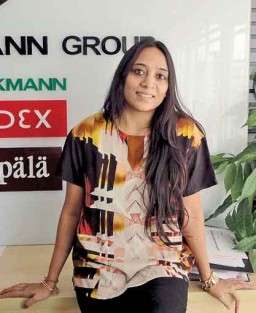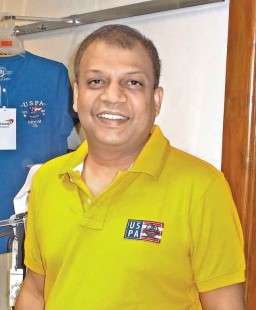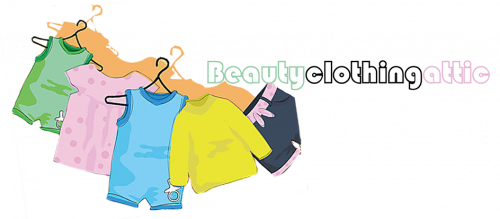
Global competition is just getting tougher and garment manufacturing countries are going all out to attract the buyer who is dictating his terms from product to price. Added on to this is the fact that manufacturing in China is decreasing, and slowly but steadily buyers are either already shifting some business out of the country or looking to do so in the near future. It is also clear that buyers do not want to put all their ‘eggs in the same basket’ so as to say and therefore prefer to spread their sourcing required between two or three manufacturing countries to dilute risk. Considering the evolving matrix of sourcing, many new buying patterns may be expected to develop… one which is already being used by many retailers is to buy in ‘regions’ rather than in ‘countries’ and one regional hub that has the potential to service almost all sourcing needs of international brands is the ‘India-Bangladesh’ combine…
At a seminar last year Deepika Rana, Executive Vice-President and Country Director, Li & Fung, India openly admitted that sourcing from India without including Bangladesh is unviable. She in fact goes a step further to add Pakistan and Sri Lanka in the regional net so that between these four countries buyers can get a complete vertically integrated supply chain from fibre to finished product with capabilities to do a product range from basics to high-fashion in various product categories. “The region as a hub is a paradise with each country having core strengths. While India and Pakistan are fully integrated with India scoring on design, Bangladesh has cheap labour and Sri Lanka the efficiencies,” says Deepika. Between the countries there is labour cost advantage, GSP advantage, raw material availability, product strength to do almost any category including home furnishing and leather, articulation on design, and to top it all the communication skills to understand and feed the buyer.
[bleft] Most buyers agree that India and Bangladesh should not be looked upon as competitors; and one can consider the two countries more as a region with complementary synergies – each having their own strengths – in terms of product, capacities, flexibility and value add services. To a brand or retailer, both countries will have relevance, specific to the needs of the brand/retailer . [/bleft]
Today, most buyers are aggressively looking to develop alternate bases to China. “China may still be huge, but for long-term sustenance it is important to spread out the risk… While most buyers are already in Vietnam and Cambodia, India and Bangladesh together are an exciting combination to handle both core programmes and fashion,” says Christopher Tse, CEO, Contempo Limited, adding they are under-invested in these two countries and the strategy is to consolidate the operations in the region over the first three years, build a strong vendor base and explore product options. The India office under Leela Kanuga is responsible for developing vendor base in Bangladesh also. The biggest advantage of Bangladesh according to Leela is of GSP preference in both Europe and Canada. “As of today, if my Canadian buyer has a sharp price product then I may lose order if India price is high, but I will get the order if I go to Bangladesh even if the FOB price is the same due to duty benefit, as Bangladesh goods will land 18 per cent cheaper in Canada,” reasons Leela.

Today, most of the buyers know exactly what they want to source and from where. H&M which is a major buyer for both countries has a very well defined product profile for India and Bangladesh. Sourcing majorly for tops and dresses from Indian manufacturers, H&M banks on Indian strengths looking for those pieces which are more embellished and sequined along with garments that are a little more stylized in terms of value-added details like gathering, pleating and ruching. FOB’s range from a minimum of US $ 2 for very basic pieces which have almost no details, to a maximum of US $ 15 for pieces that are more complicated and high fashion. From Bangladesh, products sourced include mass volumes of basic jerseys and sleeveless T-shirts with minimum quantities of 2 million pieces with FOBs which are less than US $ 7. Very basic items have lead times as less as 24 days which can go up to 3 months for other categories like jackets, outerwear, leggings, sweat tops and night suits, along with volumes of bottoms in menswear categories like cargos and shorts. Another important product category from Bangladesh is of denims, lead times for which are up to 124 days, and FOB’s range from US $ 9 to US $ 10.
[bleft] Denims are in fact, one of the major categories for most buyers and a few years ago, India lost a lot of its denim business to Bangladesh, mostly from GAP. What GAP has retained in India is denim products with handwork on it, accounting for around 15% of total buying of denim from the region. [/bleft]
Denims are in fact, one of the major categories for most buyers and a few years ago, India lost a lot of its denim business to Bangladesh, mostly from GAP. What GAP has retained in India is denim products with handwork on it, accounting for around 15% of total buying of denim from the region. “Value added styles are more frequently attempted by factories that have skilled workforce as against automation as required to do basic jeans, which is why the value added segment is still with India,” argues Yogesh Khurana, MD, GAP. Today Lindex is sourcing about US $ 80 million worth of goods from Bangladesh, and in denim it sources nearly 60% of the product group from Bangladesh. “The way the business in Bangladesh is booming it is important to have an office in the country. As I see it, India is a very niche market, while Bangladesh is the market for everybody,” says Suman Tripathi, Country Manager, Lindex (BD).

According to global statistics, for the US the top three manufacturing hubs for denim wear are Mexico, China and Bangladesh, who between them account for about 45% of total imports to the US in denim wear. In the EU the top countries are China, Turkey and Bangladesh and they collectively account for around 54% of total imports to the region. India hardly has a role to play in this category and is facing an uphill task as it cannot compete on prices. The costing of a denim product goes haywire right from the fabric stage. “A standard washed denim from an Indian mill costs around Rs. 150 (US $ 4-5) a metre in India, the same fabric is available in Bangladesh for US $ 2-4, added to that is the CMT cost which is around US $ 16-18 per dozen in Bangladesh and would work out at around US $ 25-30 per dozen in India. On final costing a pair of jeans which works out to US $ 5-7 in Bangladesh would cost a buyer over US $ 10 in India,” reasons Roopak Malik, Director – Textiles Sourcing Limited.
In the boxer shorts category, Bangladesh has outpriced India and American eagle – one of the prominent buyers for this category has shifted its entire boxer sourcing from India to Bangladesh and China, which are manufacturing at Rs. 202.8 per piece, as against India’s price of around Rs. 273 to Rs. 286. Again India has never been competitive in good casual bottoms which are chino shorts and pants in twill and canvasses with different types of washes. This is due to fact that the fabric used in this category is basically twill and canvas, both of which are un-competitively priced in India.
[bleft] “When people come to Bangladesh they want it cheap and they don’t want to pay for high-end techniques like digital prints.” [/bleft]
In the sweater category, Bangladesh is the first preference for most of the buyers. “All our sweater needs are being met by the Bangladesh office as the country has redefined the quality needs of basics and in much lesser price, a good quality sweater can be almost 30% cheaper from Bangladesh if landing in Europe, which is a big difference,” shares Sudarshan Sharma, Director, CD Lifestyle. He adds that even in T-shirts if it is a basic printed one, Bangladesh is the choice, but if the buyer wants double mercerized, yarn dyed with washes or some multi layered value prints than Tirupur is the destination.
To counter balance the cost of manufacturing, many exporters from India are targeting high value buyers from Europe and US market for brands like Ralph Lauren, Abercrombie, Brooks Brother, Hugo Boss, Charles Tyrwhitt to name a few. Products sourced by these brands are retailed at US $ 60 and above and in smaller quantities. Dip dyed shirts, hand embellished garments are well received by US and European markets and these products are India’s strength with no competitors as such. “Easy fabric imports regulations allow Bangladesh great flexibility in fabric sourcing and are increasing its popularity in those fashion garments where imported fabrics are required. But where Indian fabrics are preferred in fashion, India is the hub for sourcing,” says Suman.
Also, even as Bangladesh is trying to increase its fashion element, limitations remain. “When people come to Bangladesh they want it cheap and they don’t want to pay for high-end techniques like digital prints. They say, if we have to buy digital we can go to any part of the world why come to Bangladesh,” says Amit Bansal, MD, SA Sourcing (BD). The challenging aspect of doing fashion in Bangladesh is keeping prices down, despite the value addition. For the Indian domestic brand Madura, SA Sourcing is majorly buying tops and formal shirts, while for Arvind they are sourcing T-shirts, formal shirts and casual shirts from Bangladesh. After 7 years of deep understanding of the industry, Amit feels that Bangladesh is still at a very nascent stage in fashion. “For handling multiple styles, you need a strong middle management, as it is important to have a trained person to coordinate between different processes and departments, as required in fashion, but in Bangladesh there is acute shortage of young professionals to handle the middle management,” adds Amit.
[bleft] “China may still be huge, but for long-term sustenance it is important to spread out the risk… While most buyers are already in Vietnam and Cambodia, Bangladesh and India together are an exciting combination to handle both core programmes and fashion.” [/bleft]
ZXY Buying Office, sourcing about US $ 120 million worth of goods from Bangladesh is expanding its operations in the region to offer international buyers a wide variety of products from basic polo T-shirts to high value lingerie. In India, the buying office has operations in Noida which is the sourcing hub for products like blouses and fleece flat knits, and one office in Tripura for fashion knits. “In knits, from Bangladesh we do 20-25 lakh pieces every month, while the Tirupur office sources around 2 lakh pieces per month of more value added knits,” says Abby Jamal, MD, ZXY Buying Office. He adds that while the minimum labour cost in Bangladesh is US $ 50, in India it is almost around US $ 120-130, so most buyers shifting out of China want to source from Bangladesh.
At Asmara, while the India office was intimated in 2004 for sourcing casual fashion, outerwear, bottoms, shirts, high-end garments, accessories, leather and home products, the Bangladesh operations came a year later in 2005. “With a global presence we can place an order in the country best suited for the product on one hand and on the other we can bring in brands from other centres, which may otherwise not be too keen to work in India simply because they believe in our services and delivery capabilities,” reasons Devender Gupta, Director, Asmara International. In Bangladesh, the product mix for Asmara is basic knits for Tom Tailor and 100% woven for A&F. “We do not do knits for A&F from Bangladesh as they are more value added and the lead times are very short. We did try for a season but after that we moved it to India because after importing the knitted fabric delivering the garment in 90 days was impossible. We are now focusing only on wovens, 90% of fabric is being imported from Pakistan and we are converting it here. We do 95% bottom-cargos and chinos and 5% jackets, no shirts, all casual heavily washed,” informs Manish Ojha, Country Manager, Asmara Bangladesh.
[bleft] “The region as a hub is a paradise with each country having core strengths. Between the countries there is labour cost advantage, GSP advantage, raw material availability and product strength to do almost any category.” [/bleft]
Interestingly, all the buyers who shared their views agreed that India and Bangladesh should not be looked upon as competitors; and one can consider the two countries more as a region with complementary synergies – each having their own strengths – in terms of product, capacities, flexibility and value add services. To a brand or retailer, both countries will have relevance, specific to the needs of the brand/retailer. In certain product categories, there could very well be an overlap in the two countries – examples are men’s shirts or jersey tops. But, then there would be further differentiation by way of value add either in quality, treatment or design which would then make the difference in the price and positioning of the product.
Says Vivek Bhatnagar, CEO, Fusion Consulting Services, “To my mind we are not competitors rather we are complementing each other and customers are the ones who want to view and think and use the negotiation towards their advantages despite all the issues that Bangladesh sourcing brings along with it, it is imperative for brands and fashion retailers to source out of Bangladesh and India. The sheer need for profitability and numbers drives every large order towards Bangladesh with its low prices and duty-free advantages.”
European brands need Bangladesh especially for the classic basics and the fashion basic start price level. All fashion retailers in Europe who are at the very top, source from Bangladesh not only due to price advantage but also the sheer size of their orders. “Look at the Zara, H&M, Bershka products in the core basic categories, those quantities are upwards of 2,00,000 pieces a style and to be turned around in 100 days with multiple styles and articles to be produced in the same period.
[bleft] “India hardly has a role to play in denims and is facing an uphill task as it cannot compete on prices. The costing of a denim product goes haywire right from the fabric stage in India.” [/bleft]
How many large manufacturers does India have who can deliver on a consistent and regular basis at that level?” questions Vivek. Fusion also takes the decision where to place the order based on the need and meeting these aspects of the enquiry, as opposed to the product category competition. “India can make bottoms and so does Bangladesh; India also makes flat knit sweaters and so does Bangladesh; India – Tirupur also makes basic T-shirts and so does Bangladesh; yet the sheer size of a factory, the working capital and the productivity necessary for profitability exists in Bangladesh and not in India,” concludes Vivek.

Leave a Reply